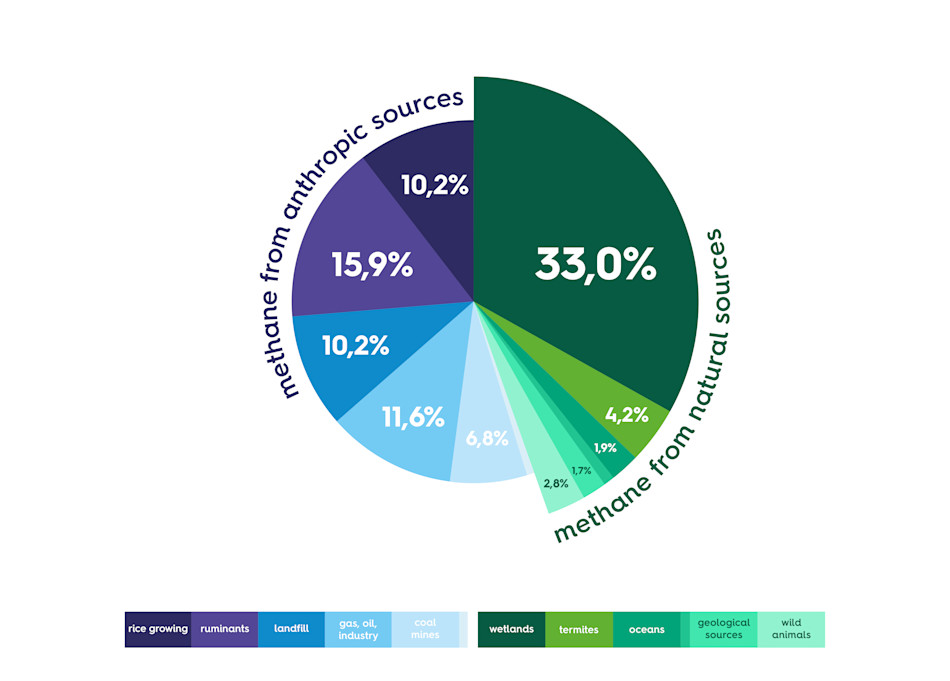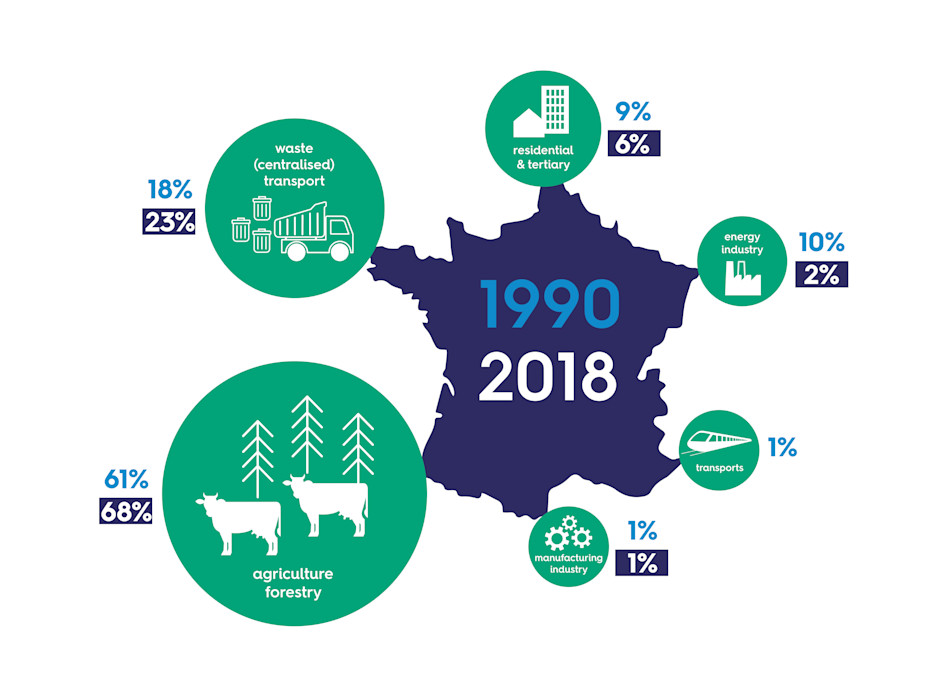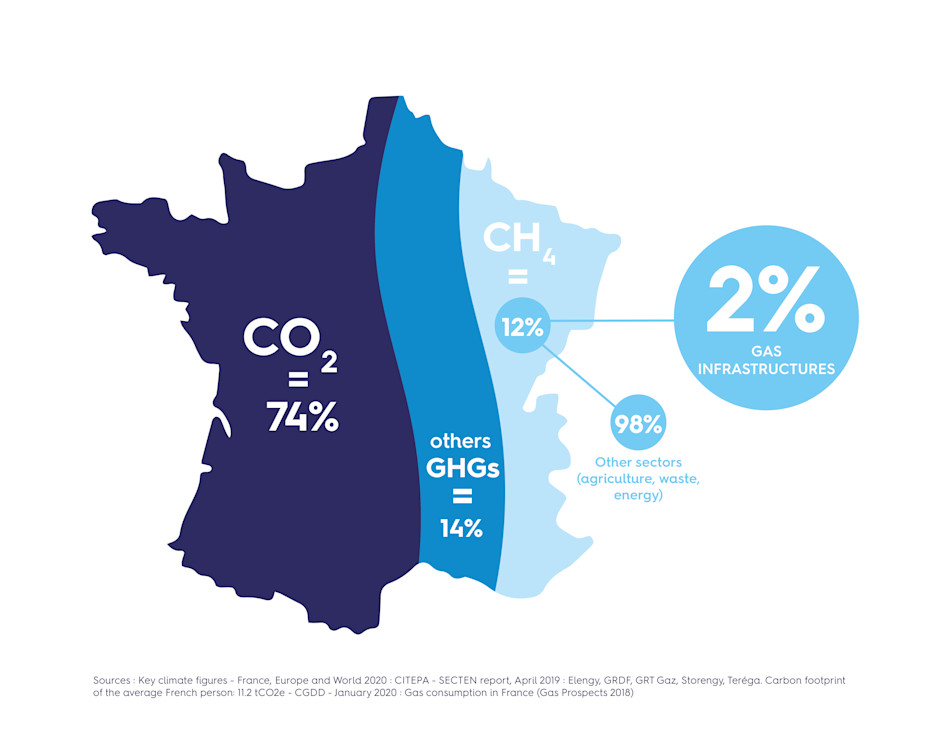Urgence gaz 0 800 028 800

A gas industry committed to reducing methane emissions
When it comes to methane emissions, 2020 will not be remembered as a “vintage year”: indeed, worldwide emissions started rising again. However, there is growing acceptance that a problem exists, and change is starting to happen. Europe, for example, is the only region in the world where emissions fell. For its part, Teréga has incorporated this issue into its environmental policy and is developing practical actions for many years.
What is methane?
While CO2 is well known among greenhouse gases (GHG), there is one volatile organic compound (VOC) which stands apart from the rest, but which is equally important: methane (CH4). Since 1750, the quantity present in our atmosphere is believed to have increased by nearly 150%! 570 million tonnes are emitted worldwide every year, and one third of the greenhouse effect is down to methane alone.
There are three main sources of methane emissions:
Biogenic. Originating from wetlands, animal sources as a result of mastication, or landfill as a result of fermentation.
Thermogenic. Created by the cracking of organic molecules underground, which may be caused by leaks from marine or terrestrial sedimentary basins, volcanism or geothermics, and fossil fuel operations, transport and use.
Pyrogenic. Originating from the combustion of organic materials (stubble burning, forest fires etc.).
Distribution of methane emission sources

According to the IPCC (Intergovernmental Panel on Climate Change), methane is “the second most important GHG regulated under the Kyoto Protocol to contribute to global warming, with a global warming potential (GWP) 34 times higher than that of CO2.” And while it persists for a shorter time in the atmosphere than CO2 – about 12 years compared with around a hundred years for CO2 – its warming potential is much higher. Looking a hundred years ahead, it is 34 times higher; looking twenty years ahead, it is 86 times higher!
What is the situation with methane emissions in France?
Methane is implicated in the problems of both climate change and atmospheric pollution (ozone). In its 2018 report, the IPCC stresses that to limit global warming, those emissions must be reduced by 35% between now and 2050 (compared with 2010 levels). Unfortunately, in 2020, a rise in methane emissions worldwide was recorded.
However, by contrast, they reduced at the European level. In France, methane emissions saw a significant drop over the 1990-2018 period of 13.2 MtCO2e (CO2 equivalent), which is about 20%. That drop was linked in particular to changes in the energy transformation sector, alongside optimisation work on the gas transport and distribution grid.
Taking this further, the national low carbon strategy (SNBC) sets out a target for the methane over the 2019-2023 period: a further drop of 7.3% compared with 2018.
Changes in the distribution of methane emissions in France

Despite a slight reduction, the farming sector remains the main source of methane emissions, largely due to enteric fermentation and animal waste. In its report “Bilan des émissions en France de 1990 à 2018” (Report on emissions in France, 1990-2018), CITEPA (French Technical Reference Centre for Air Pollution and Climate Change) explains: “Farms can introduce reduction techniques, the most widespread of which is methanisation. It does not enable restriction of the amount of methane produced; on the contrary, it encourages it with a view to capturing it for energy production. ”
The gas chain certainly has a role to play in this area.
What is the gas sector doing about methane emissions?
While the farming sector is the biggest source of emissions in the world, the use of fossil fuels comes next. At installations which form part of the gas supply chain (upstream, production, transport), methane emissions – excluding the combustion stage – fall into three categories:
fugitive emissions, produced when installations are operating normally,
“ventings”, where systems are opened directly to the air during maintenance operations, incidents, works etc.,
incomplete combustion.
According to the 2017 report “Analyse du cycle de vie de la chaîne gazière” (Lifecycle analysis of the gas supply chain), French gas operators (transport, storage, distribution, methane tanker terminals) account for about 2% of the french gas supply chain’s impact on climate change.
The transport and distribution segments are the lowest emitters.
Transmission, production and combustion have the greatest impact.
Gas extraction in Norway and Russia and the way those gases dominate the French supply mix explain the impact of production.
Added to which, players in the European gas industry, including Teréga, are now active under the umbrella of the “Oil & Gas Methane Partnership 2.0” (OGMP), a partnership launched by the United Nations Environment Programme (UNEP). Its target: to achieve a 45% global reduction in methane emissions between 2016 and 2025. Here, French operators want to step up their actions, improve the level of accuracy and reporting of their emissions, and to be involved in cooperation and the sharing of best practice.
Contribution from gas infrastructures to greenhouse gas emissions in France

What action is Teréga taking on methane emissions?
Because we are a responsible actor, we are aware of the challenge presented by methane emissions. To that end, our approach is proactive and is incorporated into our corporate environmental “BE POSITIF” programme. Research & Innovation (R&I) is working with the operations department specifically on these emissions, which account for 30% of our total GHG emissions. This has allowed us to develop mapping of which equipment produces the highest emissions and to test technical reduction solutions.
Clamping down on works “venting”
By optimising our equipment and procedures, we have already managed to reduce our emissions from venting by more than 80%.
- the MOBILE COMP solution is a mobile compressor, allowing gas to be recovered from a pipeline that has been emptied for works. It can then be recompressed and reinjected into the grid. This enables us to avoid about 10% of GHG emissions.
- The RECOMP solution is a permanent compressor which recovers emissions from compression stations, recompresses them and reinjects them into the grid. It allows 17,000 tCO2eq to be recovered every year.
Optimisation of gas installations
Our first “hot flare” was brought into service in 2018. It allows us to burn off natural gas which cannot be reinjected into the grid. That step enables us to transform methane into CO2, which has approximately ten times less GHG impact.
Clamping down on fugitive emissions
For the three compression solutions, we have invested in integrated electric compressor technologies which do not suffer from leaks. And for our existing assets, we have initiated a R&I project for the recompression of leaks from seals, entering the pilot test stage in 2021.








